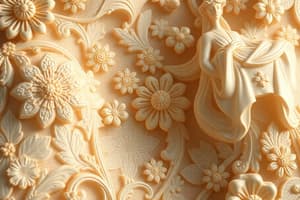Podcast
Questions and Answers
Which of the following defects in ceramics involves a cation moving into an interstitial space?
Which of the following defects in ceramics involves a cation moving into an interstitial space?
- Non-stoichiometry
- Point Defect
- Frenkel Defect (correct)
- Schottky Defect
What is the main effect of non-stoichiometry on ceramic materials?
What is the main effect of non-stoichiometry on ceramic materials?
- Increased tensile strength
- Improved thermal conductivity
- Enhanced reactivity
- Altered electrical and mechanical properties (correct)
- All of the above
What type of application of ceramics is NOT mentioned in the content?
What type of application of ceramics is NOT mentioned in the content?
- Energy Storage
- Agriculture (correct)
- Aerospace
- Medical Industry
- Electronics
Which of the following is NOT a future development in ceramic materials mentioned in the content?
Which of the following is NOT a future development in ceramic materials mentioned in the content?
In which application are ceramic materials used to protect against extreme temperatures?
In which application are ceramic materials used to protect against extreme temperatures?
Which of the following is NOT a feature of the Schottky defect in ceramics?
Which of the following is NOT a feature of the Schottky defect in ceramics?
What is the primary function of bioceramics in the medical industry?
What is the primary function of bioceramics in the medical industry?
Which of the following is NOT a factor influencing the properties of ceramic materials?
Which of the following is NOT a factor influencing the properties of ceramic materials?
What is the primary focus of study in the field of Materials Science and Engineering?
What is the primary focus of study in the field of Materials Science and Engineering?
Which of the following is NOT a key characteristic of ceramics?
Which of the following is NOT a key characteristic of ceramics?
Which Greek word does the term 'ceramic' originate from?
Which Greek word does the term 'ceramic' originate from?
In the context of ceramics, what is the primary difference between the rock salt structure (NaCl) and the cesium chloride structure (CsCl)?
In the context of ceramics, what is the primary difference between the rock salt structure (NaCl) and the cesium chloride structure (CsCl)?
Which of these crystal structures is particularly relevant in electronics, especially for capacitors and piezoelectric materials?
Which of these crystal structures is particularly relevant in electronics, especially for capacitors and piezoelectric materials?
What type of chemical bonding is typically present in ceramics?
What type of chemical bonding is typically present in ceramics?
Which of these is NOT a key feature of the Zinc Blende (ZnS) structure?
Which of these is NOT a key feature of the Zinc Blende (ZnS) structure?
Why are advanced ceramics playing an increasingly important role in diverse industries such as electronics, aerospace, and medical technology?
Why are advanced ceramics playing an increasingly important role in diverse industries such as electronics, aerospace, and medical technology?
Flashcards
Materials Science
Materials Science
The study of materials and their properties, structures, and applications.
Ceramics
Ceramics
Inorganic, non-metallic materials often derived from metallic and non-metallic elements.
Crystal Structure
Crystal Structure
The arrangement of atoms in a crystalline solid, affecting properties of materials.
Rock Salt Structure
Rock Salt Structure
Signup and view all the flashcards
Cesium Chloride Structure
Cesium Chloride Structure
Signup and view all the flashcards
Zinc Blende Structure
Zinc Blende Structure
Signup and view all the flashcards
Perovskite
Perovskite
Signup and view all the flashcards
Properties of Ceramics
Properties of Ceramics
Signup and view all the flashcards
Frenkel Defect
Frenkel Defect
Signup and view all the flashcards
Schottky Defect
Schottky Defect
Signup and view all the flashcards
Non-stoichiometry
Non-stoichiometry
Signup and view all the flashcards
Ceramics in Electronics
Ceramics in Electronics
Signup and view all the flashcards
Ceramics in Aerospace
Ceramics in Aerospace
Signup and view all the flashcards
Bioceramics
Bioceramics
Signup and view all the flashcards
Ceramic Nanomaterials
Ceramic Nanomaterials
Signup and view all the flashcards
Self-healing Ceramics
Self-healing Ceramics
Signup and view all the flashcards
Study Notes
Materials Science: Ceramics
- Materials Science is the study of materials' behavior, properties, structures, and manipulation for various applications.
- Ceramics are inorganic, non-metallic materials made through high-temperature processes.
- Ceramics, from traditional clay and porcelain to advanced materials, are crucial in electronics, aerospace, and medicine.
- Ceramic structures are more complex than metals due to multiple elements, ranging from ionic to ionic-covalent bonding.
Key Ceramic Structures
- Rock Salt (NaCl): Cations and anions alternate in a cubic arrangement.
- Cesium Chloride (CsCl): Cation at the cube center, simple cubic design.
- Zinc Blende (ZnS) and Diamond Cubic (SiC): Tetrahedral coordination, common in semiconductors.
- Perovskite (BaTiO3): Crucial in electronic ceramics (capacitors, piezoelectrics).
Defects in Ceramics
- Frenkel Defect: Cations leave normal sites and move to interstitial spaces.
- Schottky Defect: Vacancy pair (missing cation and anion), impacts ionic conductivity.
- Non-stoichiometry: Unequal element ratios, affecting electrical and mechanical properties.
Ceramic Applications
- Electronics: Semiconductors, insulators, superconductors.
- Aerospace: Heat-resistant tiles for spacecraft protection.
- Medical: Bioceramics for implants and prosthetics (biocompatibility).
- Energy Storage: Lithium-ion batteries, solid oxide fuel cells.
Future of Ceramic Materials
- Researchers develop ceramic nanomaterials, self-healing ceramics, and lightweight composites.
- AI and machine learning enhance prediction of ceramic properties and discovery of new compositions.
Studying That Suits You
Use AI to generate personalized quizzes and flashcards to suit your learning preferences.




